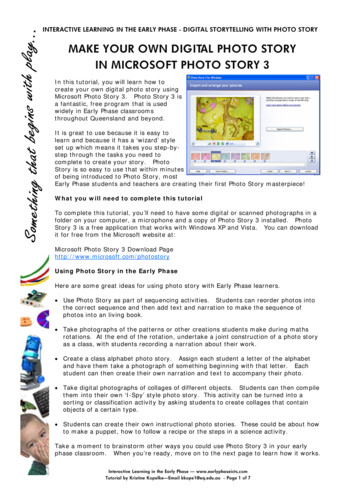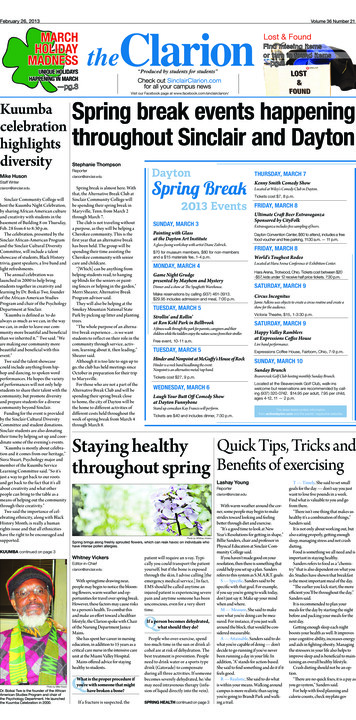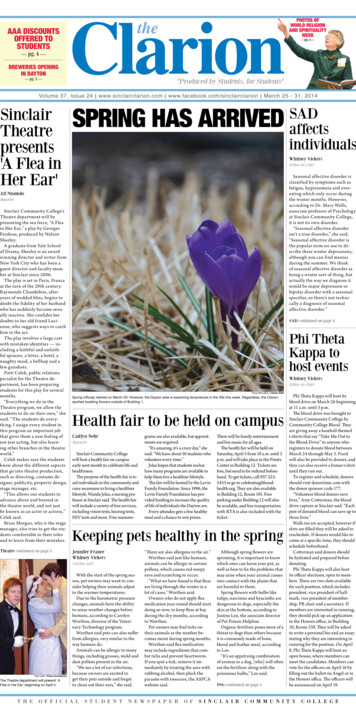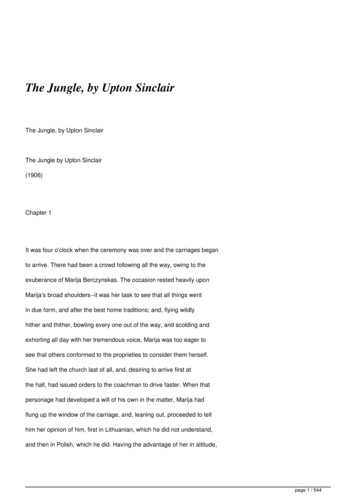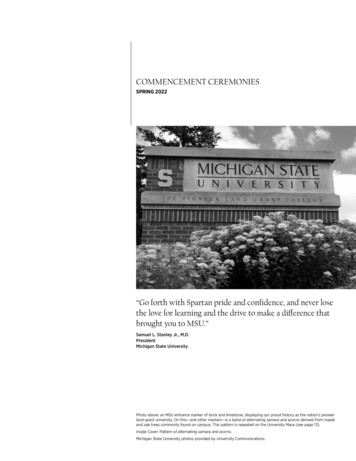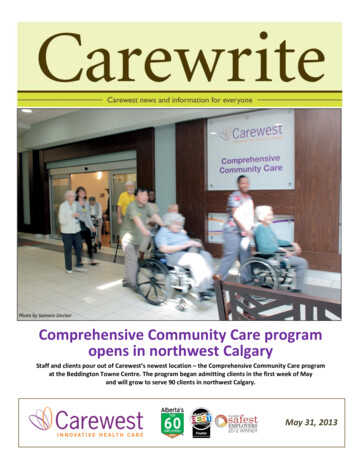
Transcription
Photo by Samara SinclairComprehensive Community Care programopens in northwest CalgaryStaff and clients pour out of Carewest’s newest location – the Comprehensive Community Care programat the Beddington Towne Centre. The program began admitting clients in the first week of Mayand will grow to serve 90 clients in northwest Calgary.May 31, 20131
This month inCarewrite3.Rose Tea celebrate 50 wonderful years4.Kindness board sparks inspiration5.New expense claim process forCarewest6.Know, show and grow your essentialskills7.Carewest Garrison Green welcomesstudents7.Alzheimer prayerImportant change tomassage therapy benefitsRuth ZwolinskiManager, Compensation & BenefitsIf you are an Alberta Blue Cross member and you usemassage therapy services, you should be aware of a changethat will occur this summer.Beginning Aug. 1, 2013, Alberta Blue Cross will requiremassage therapists to meet either 2,200 hours of formaleducation or a 2,200-hour competency equivalency to beeligible under your plan.8.Seniors’ Week runs from June 3-9,2013You are encouraged to ensure your massage therapist has thecorrect training and education prior to treatment.8.Staff Appreciation WeekAsk your massage therapist if he/she is an Alberta BlueCross approved provider or call Alberta Blue CrossCustomer Services at 1-800-661-6995 to confirm yourprovider meets your requirements.9.Word finding problems?10 National Hospice Palliative Care WeekMay 5-11, 201311 Gift shop catwalk12 Falls feature: risk assessment &communicationMassage therapy providers were informed of thisrequirement in May 2012 to allow them time to obtain anynecessary upgrading in order to be considered an eligiblemassage therapy provider by Alberta Blue Cross.14 Food Services update14 Virtual reality showcased at OSI openhouse15 Employee Profile: Amina Haib16 Updating the diet board becomestherapeutic activity17 Volunteer’s passion for art helps others18.Our clients’ stories: Evelyn GlambeckNext issue Next submission deadline: June 6Publishing date: June 28Submissions are welcome from everyone Staff, residents/clients and their families,volunteers, students, etc.Please see the back cover for details.If you have questions or concerns, contactAlberta Blue Cross Customer Servicesat 1-800-661-6995.2
Rose Tea celebrates 50 wonderful yearsSamara SinclairManager, CommunicationsEverything was coming up roses at CarewestSarcee when the Calgary South Rotary Partnersattended to present their 50th annual Rose Teaservices to the residents at the care centre.The group hired Memory Lanes Fashions – atheatrical group that models fashion from theearly 1900s to the delight of onlookers.Kelly Baskerville, Client Service Manager,presented a plaque after the show, bearing theinscription ‘This plaque is in recognition of 50years of dedication and support to CarewestSarcee from the South Calgary Rotary Partners’.“I cannot put into words the impact this group hashad on our site,” said Kelly. “It makes those of uswho work for Carewest proud to share yourlegacy.”The Rose Tea tradition has grown over the last 50years to blossom into one of the most highlyanticipated events at the care centre.And at this year’s 50th anniversary Rose Tea,there was more to celebrate, in addition to fivedecades of bringing joy to the residents at Sarcee.This year, the Rotary Partners pledged a donationthat will improve the indoor and outdoor spaces atthe care centre – two garden benches for thegardens on Sarcee property and funds to updatesome of the tub rooms for the long-term careprogram.The Rotary Partners are the spouses of Rotariansand are key members of the Rotary Club ofCalgary South, contributing to many projects andevents throughout the year.This year’s donation wouldn’t have been possiblewithout the work of hundreds of volunteers sellingtickets for a draw on the Rotary Dream Home duringthe Calgary Stampede.Photos by Samara Sinclair(Top) A plaque bearing the inscription, ‘This plaque is inrecognition of 50 years of dedication and support toCarewest Sarcee from the South Calgary Rotary Partners’was presented by Client Service Manager Kelly Baskervilleat the South Calgary Rotary Partners 50th annual Rose Teaservice for Sarcee’s residents and clients.Pat Farn, Calgary South Rotary Partners,watches from the background.(Bottom) Gord Donovan with Memory Lanes Fashionsdelights the crowd with a few theatrics as he displaystypical bedtime attire that might have been wornearlier last century.Continued on Page 4.3
Rose Tea celebrates 50wonderful yearsContinued from Page 3.Carewest staff willing to help sell tickets during the 2013Calgary Stampede taking place July 5-14 would be muchappreciated by the Rotary club.It is only for a few hours with a choice of morning,afternoon or evening shifts and always a fun experience.Volunteers will be provided with a free ticket forentrance onto the grounds.Should you be interested in helping out,please contact Susan Brick with the CalgarySouth Rotary Partners at 403-271-7734.Photo by Samara SinclairTwirling her parasol for the audience at CarewestSarcee, Iris Hobbs models an outfit thatwas all the rage in the early 1900s.Photo by Samara SinclairPhoto by Samara SinclairKindness board sparks inspirationArt celebrated at annual showMessages of kindness grace the whiteboard in the staffroom on the Regional Community Transition Program(RCTP) unit at Carewest Dr. Vernon Fanning. TheKindness board spells out different ideas as to how staffcan be kind to themselves and others. This is an exampleof how Carewest nurtures and celebrates kindness aspart of their corporate culture.This lovely piece of art, painted by a residentat Carewest Colonel Belcher, was one of many ondisplay at the care centre during their art showin April. Carewest is home to many artists who haverecently discovered their talent, thanks in part tothe art programs offered by Carewest. See Page 17for a look at the art programs from a volunteer’sperspective.4
New expense claim process for CarewestSamara SinclairManager, CommunicationsThe process for filing an expense claimfor travel, hospitality or workingsessions has just changed. Anyoneclaiming things like mileage,parking, taxis, transit, hotels ormeals must now follow Carewestprocess, which have been alignedwith the new AHS policy andprocesses to ensure timelypayment.You can find detailed instructions onhow to complete this form properly inthe document mentioned earlier –“Carewest Expense Claims forlocal, provincial and out-ofprovince travel”.As per usual, you must attachoriginal receipts but now you alsohave to write on each receipt andinclude some specific information –such as the business nature of the purchase orexpenditure, who was involved and the date.Two documents will guide you through the process ofcreating a proper expense claim using the appropriateforms: Carewest Expense Claims for local, provincial andout-of-province travel. Carewest Policy AM-01-02-03: Travel,Hospitality and Work Session Expenses.You must number and collate the receipts in the sameorder you list them on the expense form.Make sure to include your employee number,functional centre numbers, all appropriate signaturesand DOFA (Delegation of Financial Authority) level,as outlined in the instructions.Both items can be found on Careweb.In the past, staff used the Carewest Filemaker ExpenseClaim form. There have been a couple of changes tothis form, which will affect whether claims are paid.Delegation of Financial Authority(DOFA) codesOn the mileage page, under the “Reason” column,Filemaker typically gives you three choices as to whyyou need to travel: Assessment, Meeting or Support.When you fill out an expense claim, you have tomanually enter the DOFA codes. They have beencreated in collaboration with AHS Finance and arespecific to Carewest.Now, for each entry, you have to manually enter anexplanation of why you needed to travel – forexample, Site Operations Meeting or Attending anInterview.DOFA LevelNumberLevel 405Level 410Level 415Level 420Now there’s an additional form you have tocomplete – the AHS Travel, Hospitality andWorking Sessions Expense Claim Form (#09704).This form can be found on Insite, in the AHS FormsLibrary.5AmountTypes of Employees 500 5,000 10,000 50,000SecretariesTeam LeadsManagersDirectors
Know, show and grow your essential skills!Samara SinclairManager, CommunicationsEssential skills are the skills that people need forlearning, work and life. They help people carry outtasks like filling out forms, applying for a mortgage,balancing the household budget and solving problems.Carewest has invested in a new education initiativecalled Care Essentials – assisting front-line staff inbrushing up on their reading, numeracy, documentuse, critical thinking and oral communication skills.Convinced that essential skills are critical tobuilding a skilled workforce, Carewest is investingin essential skills-related activities over the nextthree years to help more than 1,000 employeesbuild their skills.Amanda Osborne, Essential Skills Assessor, CareEssentials, says all care staff and Food Services staffwill be asked to fill out a survey as the first step ontheir path to improving their essential skills.“No matter what the results of the surveys are, this is acommitment to improvement and continuingeducation,” says Amanda.Photo by Samara SinclairAmanda Osborne, Essential Skills Assessor, CareEssentials, is helping more than 1,000 Careweststaff improve their essential skills.“We are investing in essential skills education toenrich and better the lives of Carewest staff.”The initiative itself was brought about by theeducators, who realized that, in some cases, theirclinical and non-clinical training wasn’t sticking.This is because the instructor assumes the groupalready knows how to perform math functions andfocuses on teaching new skills. The nursing staff withinadequate math skills is left behind.For example, a nursing staff member with lownumeracy skills may not understand how to calculateratios and proportions.They don’t understand key parts of the lesson and thelearning doesn’t stick.“Essential skills form the foundation that helps peoplelearn and it provides that stickiness,” says Amanda.They may be able to hide their skill deficit bymemorizing basic conversions or relying on coworkers for help.After a staff member has taken the Care Essentialssurvey, he or she will start a learning plan that iscustom-made for his or her specific profile, asdetermined by the surveys.But these strategies won’t work when the nursing staffmember participates in clinical training.Continued on Page 7.6
Forms are being updated with plain language,replacing confusing medical jargon with moremeaningful examples, graphics and colour.Know, grow and show youressential skills!Continued from Page 6.The result is a form that is easier and faster tocomplete.The learning plan provides a list of resources anemployee can access and it only focuses on the skillsthey need to build.“The overall response from staff at the sites has beenvery positive. People have been very receptive toimproving their essential skills and they appreciate theopportunity to receive training and development fromCarewest to help them improve their essential skills,”says Amanda.Many of these resources will be available to staff at nocost.While they are building a skilled workforce, Carewestis also taking immediate steps to reduce thecomplexity of workplace documents used by staff,like forms and education materials.“We’re investing in them. It’s a unique experience tohave essential skills training offered to people alreadyemployed by their company.”Alzheimer prayerSubmitted by Linnea ThomsonRegistered Psych Nurse, Carewest Colonel BelcherPlease grant my visitorsTolerance for my confusionForgiveness for my irrationalityAnd the strengthTo walk with me in the mist of memoryMy world has become.Please help them take my handAnd stay awhile,Even though I seem unawareOf their presence.Help them to know how their strengthAnd loving care will drift slowlyInto the days to comeJust when I need it most.Photo by Samara SinclairCarewest Garrison Greenwelcomes studentsLet them know that when I don’t recognize them,That I will, I will .Keep their hearts free of sorrow for meFor my sorrow, when it comesOnly lasts a moment then it’s gone.This group of Bow Valley College Health Care Aidestudents marks the first group of students tocomplete their practical education at CarewestGarrison Green. Open to the public in 2010, GarrisonGreen has now begun accepting students inpartnership with educational institutions. A groupof LPN students from Bow Valley College will be thenext group to learn the practical side of their field atthe care centre.And finally, Lord,Please let them knowHow very much their visits meanHow even through this relentlessMystery, I can still feel their love.7
Seniors’ Week runs from June 3-9, 2013Samara SinclairManager, CommunicationsSeniors make a difference in our communitiesevery day.From supporting family members and friends toassisting charities and volunteering, seniors aredeeply involved in our communities and theircontributions benefit Albertans of all ages.Each year, Carewest residents are encouragedto join the festivities by attending one of themany Seniors’ Week events held acrossCarewest sites.Please take the time to acknowledge Alberta’sseniors and all that they contribute to ourquality of life.Your participation in Seniors’ Week helpshighlight and show appreciation for Alberta'sseniors. Please keep an eye open for Seniors’Week events happening at your Carewest site.CarewestColonel BelcherJune 3 from 2-3 p.m.Seniors’ Week TeaCarewestGeorge BoyackJune 6 from 1-4 p.m.in the chapelCarewestGarrison GreenJune 3, Afternoon PianoRecital and Seniors’ TeaCarewest RoyalParkJune 5, Drumming CircleJune 7, Garden Planting andSeniors’ Week TeaStaff Appreciation WeekDuring the month of June, we take the time to reflect,acknowledge and celebrate the work that Carewest staff doevery day by marking Staff Appreciation Week.Stay tuned for more information aboutthis year’s Staff Appreciation Week.8
Word findingproblems?Speech-LanguagePathologists provide tipsBetty Norman BraySpeech-Language PathologistIt happens every day. The word is there – justat the tip of your tongue, but out of reach.You search, your mind races and you wonderif it’s the first sign of some terribleneurological illness or rapidly aging brain.It’s worse when you are tired, stressed or,sadly ladies, when have pregnancy brain,baby brain or are peri-menopausal.It’s common. Here are some suggestions. Pause. Often just waiting calmly a fewseconds is enough. Ask your listener towait also. Describe and visualize. Tell yourlistener something about what you’researching for in your mind. What does itlook like? What do you do with it?Where would you find it? Associate. Are there related words,people, things or activities that go withit? Use a synonym. Imagine what sound or letter it beginswith.Positive TalkSpeak well.Hear well.Communicating in a positive manner with your co-workers,residents, clients and families is something we strive for atCarewest. We created the Positive Talk series of booklets to help.Live well.If you’d like copies of the Postive Talk booklets, contact CarewestCommunications at 403-943-8158 or emailsamara.sinclair@albertahealthservices.caMay is Speechand Hearing Month9
National Hospice Palliative Care Week May 5-11, 2013Halley LeungCarewest Pain and Palliative Care Consulting NurseThe theme of this year’s National Hospice Palliative Care Week is "Canadians are aging. We've done themath. Have you?" We hope to encourage professionals, caregivers and the general public to advocate forbetter hospice palliative care, especially with the population aging at the rate it is. Have you done yourpart?Hospice palliative care is aimed at relieving sufferingand improving the quality of life for persons who areliving with, or dying from, advanced illness or whoare bereaved.Working together with the interdisciplinary team andprofessional staff on the unit, palliative care can beprovided at Carewest Sarcee Hospice and all thetransition and continuing care units across nineCarewest sites.It is a special kind of health care aimed at helpingindividuals and families who are living with a lifelimiting illness that is usually at an advanced stage.It may be the main focus of care when a cure for theillness is no longer possible.It begins with a simple act of kindness such asgreeting the clients and their families, offering drinksto the families when they are staying long hours,sharing updated information with families and helpingthem find resources and spiritual support whenneeded. The client can die in a comfortable, peacefuland familiar environment with dignity at Carewest.The goal is to provide comfort and dignity for theperson living with the illness, as well as the bestquality of life possible for the person and their family."Family" is whoever the person says his or her familyis. It may include relatives, partners and friends.We receive a great deal of positive feedback fromclients’ families. One family member stated, "It isworthwhile even though my husband will stay in thehospice for a very short time because I know he isgetting special and excellent care there."An important objective of palliative care is relief ofpain and other symptoms. But in addition to physicalneeds, palliative care also meets psychological, social,cultural, emotional and spiritual needs.Another family member said she felt like "the roof ofher house was collapsing" and did not know what todo. She thanked Carewest staff for taking good care ofher mother and giving her the support she needed.Palliative care services are helpful not only when aperson is approaching death but also during the earlierstages of an illness. It may be combined with othertreatments aimed at reducing or curing the illness,such as chemotherapy.Many thanks to all the dedicated staff at Carewest, thepalliative care volunteers, the doctors and the regionalpalliative care team. Together, they make hospicepalliative care possible for clients.Families also benefit from support when their lovedone is dying and after his or her death.For more information, check out the CanadianHospice Palliative Care Association website or talk toJennifer Lee, the staff of Carewest Sarcee Hospice orthe Carewest Pain and Palliative Care ConsultingService (Ruth Longhurst, Jennifer Cummings andHalley Leung).Special thanks to Jennifer Lee, Client ServiceManager, Sarcee Hospice and Ruth Longhurst,Coordinator for Carewest Pain and Palliative CareConsulting Service, for leading and guiding hospicepalliative care across Carewest.10
Spring cleaning tipsStyleathome.comWork from the top down, inside to outside, to avoidgetting what you just cleaned dirty again.Do one room, even one area of one room, at a time toavoid unfinished jobs. The satisfaction of seeing oneroom sparkle will make the hard work feel likeit's worth the effort.Gift shop catwalkThe first annual Spring & Summer Fashion Showand Gift Shop Extravaganza was a success at CarewestDr. Vernon Fanning, where residents and staff modeledthe Artizan clothing line, which will be sold at theFanning Gift Shop.In the photos to the right (top to bottom) ChristineCormier, Client Service Manager, Kelly Clavette,Manager, Support Services and Irene Muncy, TherapyAide, strut their stuff on the catwalk.Pictures by Samara Sinclair.11
Risk assessment & communicationOver the next six months, Carewrite will be home to a regular feature about falls –highlighting different aspects of the strategy, including input from sites alreadyimplementing Falls Review Committees to make Carewest safer for our residents andclients. This month, we focus on two steps in the process: risk assessment andcommunication.Risk assessmentBy assessing the risk of a fall, we can identify ways to reduce it as much as possible.Are some people more likely to incuran injury if they fall?Some people may not be at higher risk of a fall but,because of other factors, they are at higher risk of aninjury if they do fall.Key risk factors include:1. Being over the age of 85.Who is at risk of a fall?2. Having bone conditions including osteoporosis,previous fractures or metastatic bone cancer.Carewest clients are at risk of falls for many reasons.The most common risk factor is having a history offalls – it’s the biggest predictor of another fall.3. Having bleeding disorders, either due to the use ofcertain medications (e.g. anticoagulants) orunderlying conditions.Clients may also be at risk because they have: Physical problems like reduced balance or gait. Cognitive problems like dementia or delirium. Acute infections such as a urinary tract infection. Bowel or bladder urgency or frequency. Medications (and multiple medications) to treatillnesses, which can cause any of the following:4. Being post surgery, especially if they have had alower limb amputation or recent abdominal orthoracic surgery.Use the mnemonic ABCS to remember this –Age, Bones, Coagulant and recent Surgery.Change in alertness, judgment andcoordination.The likelihood of a fracture increases if the person:Increased postural hypotension (a suddendrop in blood pressure when changingposition, which causes dizziness).2. Has an unsteady gait.–Altered balance.4. Has osteoporosis.–Stiffness or weakness, which affects balance.5. Is cognitively impaired.––1. Has fallen before.3. Uses an ambulation aid.6. Smokes tobacco.Continued on Page 13.12
Falls Feature: Risk Assessment & CommunicationContinued from Page 12.What do we do at Carewest to reducethe risk of a fall?1. Within the first 24 hours of being admitted,Carewest staff screen each new client to assesstheir fall risk. We have a standard form for thisinitial screen. Some units are now trialing a newform that uses a validated Canadian tool for riskassessment. We will be introducing this form to therest of the organization in the next few months.Keeping the bed in a low position when theclient is in bed. Keeping bed rails down unless assessedotherwise. Making sure the call bell works and the clientcan work it.Making sure the client has well-fitting footwearwith non-slip soles. Keeping the room uncluttered. Keeping glasses, hearing and mobility aids inreach. Educating the client and family about the riskof falls.3. If they are assessed as having a high risk of falls,we may also:2. As part of their care plan, all Carewest clients willhave Universal Falls Precautions. They include: Make referrals to other team members, if theyaren’t already involved, to assess further,review medications or provide specializedequipment like falls mats. Create additional interventions like exerciseprograms or proactive toileting to reduce theirrisk of a fall. Monitor and change these interventions whenneeded.CommunicationOnce we have identified the risk of a fall, it is also important that we share that informationwith people who need to know about it.If everyone is well informed about the client’s riskand desired interventions, there is a better chance thatwe can reduce the risk and prevent a fall. Carewest’s falls strategy includes: Telling the rest of the care team and otherproviders about the risk and the interventionsidentified. We use the following tools tocommunicate this information:–Shift report should be used to identify newclients, those with a change in status thatmight increase their risk or anyone who hashad a recent fall.–Transfer out for care (using the “GreenSheet”).–Discharge notes.Telling the client and family about the risk anddiscussing what they can do to help reduce thatrisk. This may be done: As part of individual education. At care conferences. Prior to any passes.13
Mission BistroA fresh, new approachRobb AllenFood Services ManagerRouleau Manor& Nickle HouseMission BistroThe Mission Bistro at Carewest Rouleau Manor iscurrently adapting a new strategy to introduceitself to the surrounding area.We are developing new promotional materials anddiscounts to create loyalty programs for currentand new clients.The Grab & Go business model at the MissionBistro allows for convenience with a focus on usingas much biodegradable packaging as possible.An emphasis on fresh, seasonal foods allows forweekly menus that evolve with local andsustainable flavours.Every morning, we serve up fresh “house-made”baking – where only the finest ingredients areblended with fresh fruits or vegetables fornutritious food at great prices.Spring is here and with that will come more localproducts. The Bistro’s current and new menu willreflect the bounty of the seasons, with local foodsfeatured whenever possible.Those who visit the Bistro tell us they are delightedat the quality and value of the food and beverages.The feedback from clients is consistently positiveand it would seem everyone leaves the MissionBistro with a smile and a plan to return soon.Come and see for yourself.Virtual reality showcased atOSI open houseAbout 30 people came to experience the newvirtual reality equipment obtained by the CarewestOperational Stress Injury (OSI) Clinic, which usesexposure therapy to help clientsre-experience events in their life that may havebeen traumatic, as a way to help them workthrough feelings associated with that event from asafe place. Here, Christa Todd-Savoia, Psychologistat Orion Health Services (left), and Dr. MaryCatherine Rooney, OSI Clinic Psychologist (right),operate the unit.Photo by Samara Sinclair14
EMPLOYEEPROFILEAmina HaibCarewest employees and volunteers make upa vibrant community with diverse talents anddreams. This month, we profile Amina Haib,receptionist at Carewest Signal Pointe.Samara SinclairManager, CommunicationsIf you want it, make it happen.Part-time receptionist Amina Haib is a great exampleof positivity and resilience in the face of change,obstacle and challenge.Seated behind the desk at Carewest Signal Pointe,Amina is able to respond to and understand the widevariety of requests she might get from residents,family members, staff and visitors to the care centre –even though English is not her first language.When Amina and her family arrived in Calgary in2006, the then-resident of Haifa, Israel was up for theadventure.“At that time, my husband wanted to make a changeand wanted to look for a good life for our kids. Hefound Calgary the best place to raise kids and it wasthe boom at that time,” says Amina.Photo by Samara Sinclair“We didn’t know anybody in Calgary. I didn’t speakEnglish but I had learned some in high school. When Imoved here I joined English classes.”experience as she could and to meet other people andmake connections.About two years ago, Amina decided she wanted towork in a professional environment, mirroring her 12years of experience in Haifa as a medical officeassistant.After one year of taking English, Amina’s husbandsuggested she enter the workforce because theexperience would greatly enhance what she waslearning in school.“I started to take receptionist classes. I did somevolunteer work at the Canadian Diabetes Associationin the office and I did volunteer work during tax timeat the Centre for Newcomers,” says Amina.And so she did.She plunged into the workforce, starting at an agencythat placed her in temporary positions to gain as muchContinued on Page 16.15
Volunteer Profile: Amina HaibContinued from Page 15.“I also took a receptionist course at the CalgaryImmigration Women’s Association. For thepracticum, I wanted to work at a clinic because myprevious job was as a medical office assistant and Ithought it would be a good job. I found a clinic andam still there part-time.”In 2011, Amina applied for a position as a casualreceptionist at Carewest Signal Pointe and was hired.She moved to part-time receptionist in June 2012.Photo by Samara SinclairAmina spends her time at Signal Pointe answering thephones, greeting people when they arrive andresponding to questions and requests they may have.Updating the diet boardbecomes therapeutic activity“I am so happy with my work. I am so satisfied. I loveto work with people,” she says.Pictures can say a thousand words – words likemashed potatoes, chicken salad sandwich and Dutchapple cake. Carewest Dr. Vernon Fanning NeuroRehab client Joan Corley updates the menu and dietboard on the unit with all the meal choices andmodified textures of the day as part of a joint projectwith the speech-language pathologist, dietitian andFood Services staff. Because it was challenging tokeep the diet board up-to-date on weekdays andweekends, staff turned the task into a therapeuticactivity for clients on the unit. Joan keeps it updatedand will help train the next client who will take overthe diet board.“I feel so good when they are appreciative. When yousee they get what they need, you feel so happy thatyou did well with them.”When Amina first moved to Calgary, she enjoyedspending time at the Central Library, which was closeto her downtown English classes.She enjoys how multi-cultural Calgary is and lovesgetting to know the city and the people in it.“I had friends who are Spanish, Filipino, Chinese andwe are still we are in touch. We are busy and everyoneis working but we find time,” she says.“I love driving, even in Calgary, when I have time.That’s my hobby – to drive and to discover Calgary.Since we came many things changed. The city becamebigger and bigger. I like to discover new things. Ifsomebody calls me, let’s go.”Photo by Marlene CollinsCurious deer sneaks a peekFather’s Dayis SundayJune 16Marlene Collins, Director, Complex Continuing Care,snapped this picture back in 1995 of a curious deerthat peered into a window at Carewest Glenmore Parkto observe a meeting that was taking place in whatwas then called the Heritage Room.16
Volunteer’s passionfor art helps othersMinkee RobinsonVolunteer, Carewest Garrison GreenI volunteer at Carewest Garrison Gr
Photo by Samara Sinclair Comprehensive Community Care program opens in northwest Calgary Staff and clients pour out of Carewests newest location - the Comprehensive Community Care program at the Beddington Towne Centre. The program began admitting clients in the first week of May and will grow to serve 90 clients in northwest Calgary.

